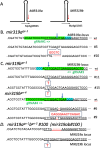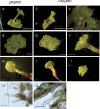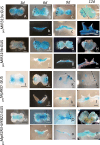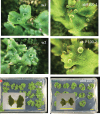MpmiR319 promotes gemma/gemma cup formation in the liverwort Marchantia polymorpha
- PMID: 40200901
- PMCID: PMC12369473
- DOI: 10.1093/jxb/eraf148
MpmiR319 promotes gemma/gemma cup formation in the liverwort Marchantia polymorpha
Abstract
miRNAs were initially detected as ~20-22 nt sequences in plants. For decades miRNA-mediated regulation of target gene expression has been characterized in many cases. The sequences of miR159/319 family miRNAs are conserved among land plants. The roles of miR159/319 have been comprehensively characterized in development of dicot and monocot plants. However, their biological function in bryophytes remains enigmatic. A model bryophyte Marchantia polymorpha also encodes miR319 at two loci and expresses the miRNA. We used a CRISPR/Cas9 system to edit genome sequences at MpMIR319a and/or MpMIR319b loci. The mutant lines developed relatively few gemma cups and gemmae, suggesting that MpmiR319 targets MpRKD or MpR2R3-MYB21 transcripts and suppresses their expression. We constructed miR319-resistant MpRKD (mMpRKD) and MpR2R3-MYB21 (mMpR2R3-MYB21) by decreasing the complementarity to miR319. Introduction of mMpRKD resulted in gemma/gemma cup-less liverwort mutants, but mMpR2R3-MYB21 did not. Transcription fusion constructs between the MpRKD promoter and β-glucuronidase showed that the gene is expressed in the rim and bottom of gemma cups. We found that the mir319a/mir319b double mutant could form gemma cups but of different sizes in a unpredictable arrangement when planted on vermiculite. These results together suggest that miR319 guides the formation of gemma cups/gemmae in standard positions in collaboration with MpRKD.
Keywords: Marchantia polymorpha; Gemma; R2R3MYB transcription factor; RKD transcription factor; gemma cup; liverwort; miRNA; notch.
© The Author(s) 2025. Published by Oxford University Press on behalf of the Society for Experimental Biology.
Conflict of interest statement
No conflict of interest declared.
Figures







Similar articles
-
SHOT GLASS, an R2R3-MYB transcription factor, promotes gemma cup and gametangiophore development in Marchantia polymorpha.New Phytol. 2025 Sep;247(6):2678-2696. doi: 10.1111/nph.70337. Epub 2025 Jul 29. New Phytol. 2025. PMID: 40734229 Free PMC article.
-
Evolutionary-conserved RLF, a cytochrome b5-like heme-binding protein, regulates organ development in Marchantia polymorpha.New Phytol. 2025 Jul;247(2):929-950. doi: 10.1111/nph.70181. Epub 2025 May 25. New Phytol. 2025. PMID: 40413697 Free PMC article.
-
Profiling and Characterization of Small RNAs in the Liverwort, Marchantia polymorpha, Belonging to the First Diverged Land Plants.Plant Cell Physiol. 2016 Feb;57(2):359-72. doi: 10.1093/pcp/pcv182. Epub 2015 Nov 19. Plant Cell Physiol. 2016. PMID: 26589267
-
The Black Book of Psychotropic Dosing and Monitoring.Psychopharmacol Bull. 2024 Jul 8;54(3):8-59. Psychopharmacol Bull. 2024. PMID: 38993656 Free PMC article. Review.
-
Behavioral interventions to reduce risk for sexual transmission of HIV among men who have sex with men.Cochrane Database Syst Rev. 2008 Jul 16;(3):CD001230. doi: 10.1002/14651858.CD001230.pub2. Cochrane Database Syst Rev. 2008. PMID: 18646068
Cited by
-
SHOT GLASS, an R2R3-MYB transcription factor, promotes gemma cup and gametangiophore development in Marchantia polymorpha.New Phytol. 2025 Sep;247(6):2678-2696. doi: 10.1111/nph.70337. Epub 2025 Jul 29. New Phytol. 2025. PMID: 40734229 Free PMC article.
References
-
- Bowman JL, Kohchi T, Yamato KT, et al. 2017. Insights into land plant evolution garnered from the Marchantia polymorpha genome. Cell 171, 287–304. - PubMed
MeSH terms
Substances
Grants and funding
LinkOut - more resources
Full Text Sources
Research Materials

